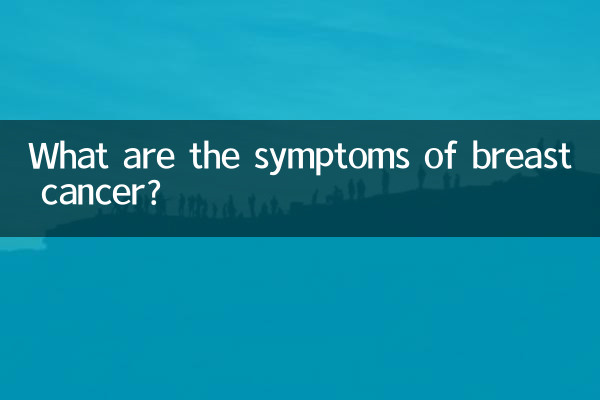What are the symptoms of breast cancer
Breast cancer is one of the most common malignant tumors in women, and early detection and treatment are crucial to improving survival rates. Knowing the common symptoms of breast cancer can help with early recognition and medical treatment. The following are the main symptoms of breast cancer and related data analysis.
1. Common symptoms of breast cancer

Breast cancer symptoms may vary from person to person, but here are some of the most common ones:
| symptom | describe |
|---|---|
| breast lump | Most breast cancer patients will feel a painless lump in the breast or armpit, with a hard texture and irregular edges. |
| Breast skin changes | The skin may appear dimpled, orange peel-like, or red and swollen. |
| Nipple abnormalities | Inverted nipples, discharge (especially bloody fluid), or skin erosions. |
| Changes in breast shape or size | Breasts may appear asymmetrical or suddenly enlarge/shrink. |
| pain | Some patients experience persistent pain in the breasts or armpits. |
2. High-risk factors for breast cancer
The following groups are at higher risk of breast cancer and need special attention:
| high risk factors | illustrate |
|---|---|
| age | Women over 50 are at significantly increased risk. |
| family history | People who have a direct relative with breast cancer are at higher risk. |
| genetic mutation | BRCA1 or BRCA2 gene mutation carriers. |
| hormone levels | Long-term estrogen exposure (eg, early menarche, late menopause). |
| lifestyle | Lack of exercise, obesity, excessive drinking, etc. |
3. Breast Cancer Screening Recommendations
Early screening is key to improving breast cancer cure rates. The following are common screening methods:
| Screening methods | Applicable people | frequency |
|---|---|---|
| breast self-examination | all adult women | once a month |
| clinical breast exam | Women over 20 years old | Once every 1-3 years |
| mammography | Women over 40 years old | once a year |
| Ultrasound or MRI | high risk groups | According to doctor's advice |
4. How to Reduce the Risk of Breast Cancer
While some risk factors cannot be changed, the following steps can help reduce your chances of getting the disease:
| measure | illustrate |
|---|---|
| maintain a healthy weight | Obesity increases breast cancer risk. |
| regular exercise | Get at least 150 minutes of moderate-intensity exercise each week. |
| Limit alcohol intake | It's best to abstain from alcohol altogether, or limit it to one drink a day. |
| breastfeeding | Breastfeeding reduces the risk of breast cancer. |
| Regular physical examination | Early detection and early treatment. |
5. Recent hot topics about breast cancer
According to the hot content on the Internet in the past 10 days, the following is the latest discussion about breast cancer:
| topic | heat | Main content |
|---|---|---|
| Breast cancer rates rising among young women | high | Data shows breast cancer cases rising in women under 40 |
| New breast cancer screening technology | middle | AI-assisted diagnostic system achieves breakthrough |
| Breast cancer vaccine development progress | high | Multiple research teams report positive clinical trial results |
| Breast Cancer Survivor Mental Health | middle | Pay attention to the importance of psychological recovery after treatment |
6. Summary
Understanding the symptoms of breast cancer is key to detecting the disease early. If you notice any abnormal changes in your breasts, seek medical attention promptly. At the same time, maintaining a healthy lifestyle and regular screening can effectively reduce the risk of disease. With the advancement of medicine, the treatment of breast cancer has been continuously improved, and the cure rate of early-stage patients has been significantly improved.
remember:Early detection, early diagnosis, early treatmentIt is the most effective way to fight breast cancer. Caring for breast health starts with understanding the symptoms!

check the details

check the details